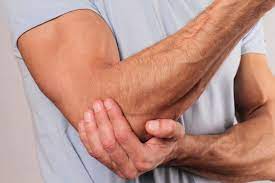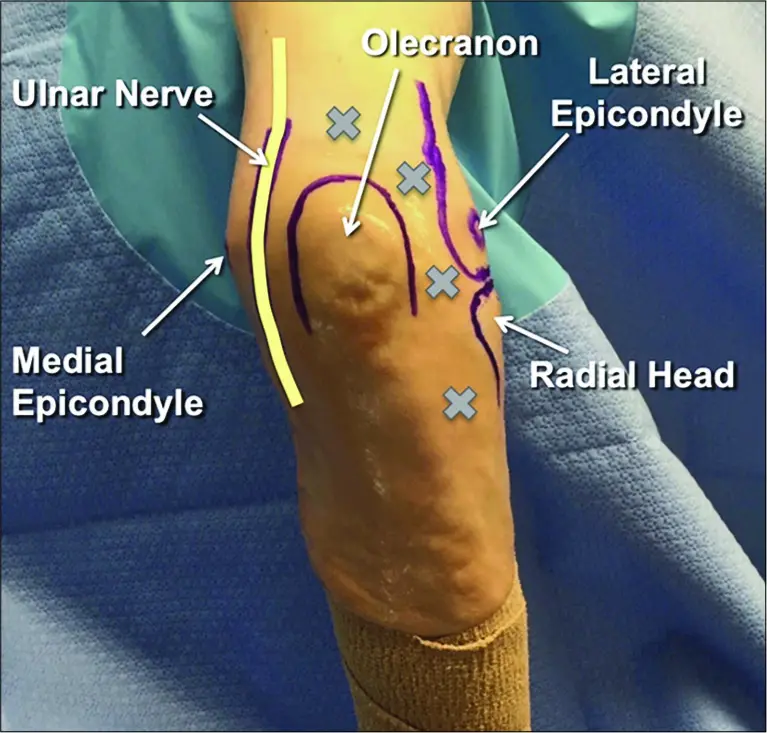Georgios Panagopoulos MD | Orthopaedic Surgeon

Table of contents
Elbow pain is very common and can cause severe problem to our everyday life & activities. A reduced elbow range of motion can compromise our ability to open the freezer, do a hand shake, or even perform our personal hygiene. Elbow arthritis can lead to loose bodies that can make our joint catch and hurt even after trivial movements. Many elbow issues of the elbow can now be treated arthroscopically, obviating the need for traditional open surgery.
What is elbow arthroscopy?
Elbow arthroscopy is a minimally invasive procedure that involves introducing a tiny camera in the elbow joint and having a look around. It is used to diagnose and treat elbow problems. Elbow arthroscopy can improve elbow function with smaller incisions, quicker recovery and less postoperative pain.

Why may I need elbow arthroscopy?
The indications for elbow arthroscopy include:
- Arthroscopic treatment of tennis elbow επικονδυλίτιδα αγκώνα
- Capsular release for elbow stiffness
- Osteochondritis dissecans
- Osteophyte debridement for early arthritis
- Loose body removal
- Arthroscopic-assisted fracture fixation
- Endoscopic treatment of partial distal biceps tears

What happens during the procedure?
Elbow arthroscopy may last 60-90 minutes, depending on the complexity of the case. During elbow arthroscopy, you will lie in the lateral position (on your side) and a tourniquet will be applied on your upper arm. Your skin will be cleaned with an antiseptic solution. The surgeon will make a small incision (4mm) in the front of your elbow and insert a small camera, called arthroscope, which will project images of your elbow joint in a video screen. The arthroscope is essentially a slim telescope (4.5mm or 2.9mm) with a high-definition camera, surrounded by a fiber-optic tube that functions as a light source. In order to see inside the joint and to undertake any procedures, the joint needs to be ‘opened’ up. This is done by distending the joint with normal saline fluid.
A specialized pump is used to control the pressure and rate of fluid going into the joint, to optimize visualization. The surgeon will make one or two more small incisions in the back of your elbow to insert tiny instruments in order to address all pathology found. Multiple arthroscopic instruments may be used during the procedure. These include probes, graspers, punches, rasps, elevators and suture cutters. Power instruments, such as shavers, burrs or radiofrequency probes may also be used. Small implants may be used during the procedure. Suture-anchors are the most common implant used during arthroscopic elbow surgery. A suture-anchor is essentially a small device made usually out of biocomposite material, loaded with sutures through a small eyelet. The anchor is placed flash with the bone and the suture is threaded through the tissue to repair. Once surgery is finished, all incisions will be closed, and a bandage will be placed on top. Your arm will be placed in a sling after surgery.
What is recovery like after elbow arthroscopy?
Recovery time depends on the underlying pathology and the type of procedure undertaken. Your doctor and physical therapist will build a rehabilitation plan customized for you. It is imperative that you start moving your elbow, as pain allows and as soon as possible, as the elbow joint is notorious for getting stiff if it does not move.


What are the advantages of elbow arthroscopy?
- This is day surgery - you may go home the very same day
- Smaller incisions - better cosmetic result.
- Postoperative pain is less, as the surrounding tissues have not been disturbed
- Quicker return to work & activities of daily living
- Actual procedure can be undertaken more accurately (under magnification and with more accurate instruments)
However, you must consider that elbow arthroscopy has specific indications. Not all procedures in the elbow can be done arthroscopically and there are many situations for which open surgery is more appropriate. Dr Panagopoulos will discuss all options with you during your visit in the office. Elbow arthroscopy is a technically demanding procedure that should only be undertaken by an experienced appropriately trained upper limb surgeon.
FAQs - Frequently Asked Questions
What is elbow arthroscopy?
Elbow arthroscopy is a minimally invasive procedure that involves introducing a tiny camera in the elbow joint and having a look around. It is used to diagnose and treat elbow problems.
What are the indications?
– Tennis elbow
– Elbow stiffness
– Osteochondritis dissecans
– Early osteoarthritis
– Loose body removal
– Arthroscopic-assisted fracture fixation
What are the advantages?
– Day surgery
– Smaller incisions
– Better visualisation = improved accuracy
– Postoperative pain is less, as the surrounding tissues have not been disturbed
– Quicker recovery
Find us
Book an appointment with us today
